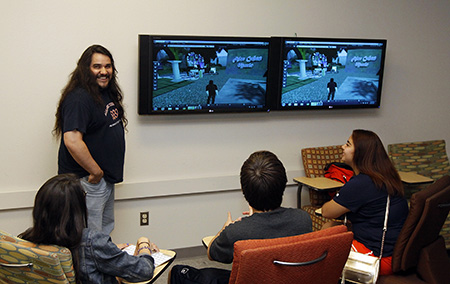By Daniel Perez
UTEP News Service
When 18 University of Texas at El Paso freshmen learned that they were enrolled in a gamification class as part of a summer preparation program, many assumed the focus would be on video games. They would have been wrong.
“Gamification: Designing to Learn” was created to tap into a person’s competitive spirit, where rewards and recognition fuel a cycle of trial and error until the student achieves success by using technology and rules used in games such as tag, chess and Minecraft.

The theory of gamification – applying the typical elements of game playing such as point scoring, competition and rules of play to other areas of everyday life – has been around for more than 10 years and has been gaining traction incrementally in academics, business and government as a way to engage and motivate people to achieve a goal. For students, statistics show those in gamified courses learn faster, retain information longer and achieve better test scores.
The UTEP course was designed by Steve Varela, associate director of Academic Technologies, to make students think, memorize, analyze, strategize, collaborate and develop solutions – and have fun in the process. The father of a high school student, he noted how his daughter’s attitude toward school changed for the worse through the years because she found learning was less and less enjoyable.
“I want students to shift their attitude about school from being something they have to do to something they want to do,” said Varela, a longtime lecturer who earned a University of Texas System Board of Regents’ Outstanding Teaching Award in 2009. “As students play the game, they get a deeper understanding of the subject.”
The summer class content covered which gaming concepts work, when they work and why they work. Students also learned about the vast and varied resources at the University Library. Varela’s online content reviews include computerized carnival shooting galleries where correct answers about databases and other literacy skills would knock over books.
As the class advanced, the games became more challenging. Students created avatars, or online representatives, who went on scavenger hunts in Second Life worlds developed or supervised by UTEP’s Academic Technologies. Students planned their path to graduation using gamification principles by the end of the course.
This was the second summer Varela offered the course and he plans to offer it again as a University 1301 class this fall.
Luis Lopez, a pre-nursing major, and Ashley Evans, an organizational and corporate communication major, were among Varela’s summer students, but neither was familiar with gamification.
Lopez, who has played the video games Halo and Modern Warfare, thought he lucked into a video game class. Evans, a non-gamer, dreaded the possibility that Lopez was right. Instead, both found methodology that would help them academically.
“It’s given me a different way to look at school that makes it more attractive,” said Evans, who learned to use and become comfortable with the Internet and social media. “Technology makes it more appealing.”
Lopez added, “It’s taught me to have fun as I’m studying. I turn it into a competition.”
Jeff Borden, Ph.D., vice president of instruction and academic strategy at Colorado-based Pearson eCollege, said data shows that students see games as opportunities to try, and if they fail, to try again until they have mastered the task. He added that researchers are studying how such factors as grit, tenacity and perseverance – aspects often present in games – are better indicators of future success than GPA and test scores.
“If the game is rich enough or surrounds a topic that is engaging enough, students can become enveloped in the experience without considering what learning is even taking place,” Borden said. “That’s powerful.”
Borden and Varela are involved in bolder projects that will grow the scope of academic games, that when done well make students feel as if they want to participate for the challenge and enjoyment versus doing something for a reward or to avoid punishment.
Varela is building a project called “Time Miner” where a UTEP adversary uses a time machine to stop the University from being created and thus also impacts the development of El Paso. Students will have to restore the community by recreating the campus one academic department and program at a time. This program, which is several years away, will be research intensive.
Borden is developing his own interdisciplinary, international and inter-institutional alternate reality game called “Contagion.” Among those on his vast planning team is Varela. Borden’s premise is the Earth is dealing with a pandemic and the world’s business, science, communication and political science students have to use technology to work together to beat back the pathogen in real time as people die and misinformation runs rampant.
“The possibilities are endless,” Borden said about gamification. “We just need some good old-fashioned training, some creativity, and (educators) have to give up some control. If we do that, it could result in an epic win for education.”